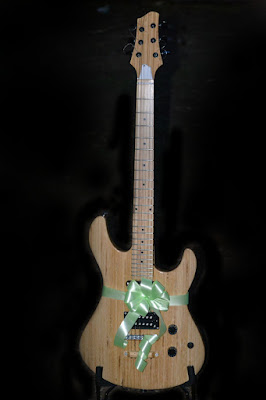Bad news. Very bad news. It definitely won’t be music to the ears of Nagaland rock bands and music fans: The recently showcased “world’s first bamboo guitar” in Dimapur “launched” on September 18 during World Bamboo Day in Dimapur is in fact neither the “world’s first bamboo electric guitar” nor “India’s first bamboo electric guitar” in any case. There are no more prizes to claim in either the electric or acoustic category as well.
In commemoration of World Bamboo Day, Nagaland Bamboo Development Agency organized a gala at the Nagaland Bamboo Resource Center at 6th Mile in Dimapur on September 18 where an electric guitar with bamboo body and neck, was introduced repeatedly as “World’s first bamboo guitar” and/or “India’s first bamboo guitar.” Some from the local Media had also hyped the instrument as being “world’s first Bamboo guitar” and so on.
Musical instruments made of bamboo are neither a new nor a recent manufacturing idea, and the contemporary guitar has not escaped found exception. For years now, iconic performance-brands such as Fender and Yamaha and sound gadget producers like ToneRider have manufactured guitars made of bamboo. Likewise, in 2011, IIT Delhi students also created a bamboo electric guitar during the institute’s Open House in New Delhi. Amateur guitar makers haven’t been far behind in showing off their “bamboo guitars” for long now. YouTube and forums boast quite a number of the bamboo pushers.
American giant Fender has even a telecaster called the Fender Lambo Telecaster “the Bamboo caster,” an electric solid body that comes with a single-coil pickup and a 2-tone. So does Yamaha, with its Bamboo Guitar FG B1, a hollow. There are also bamboo replicas of Gibson’s popular models. That’s not all though. The music market is full of bamboo plectrums, disassembled necks and bodies, cases and cabinets and tops.
Bamboo is light and strong, if processed, and its Eco-friendly image and versatility remain undisputed. However, the material’s longevity and gestation-to-processing drawbacks are one of the basic reasons guitar makers still prefer top-end wood (called ‘Tone woods’) such as rosewood, mahogany and Maple to make guitar necks and body, either electric or acoustic, solid, hollow or semi hollow.
(Right: The Bamboo Electric Guitar. Photo/Manen Aier)
Highly-processed bamboo fiber can lend a degree of credibility to the quality (such as Yamaha’s acoustic Guitar FG B1) of a ‘bamboo guitar’ but the process apparently isn’t viable for a market that still thrives on durable, highly-processed, qualified and tested materials. Naturally – no pun – manufactures still prefer Brazilian rosewood, Indian rosewood, mahogany, walnut, ash and maple than bamboo. The reason is simple: the quality of any guitar’s sound (especially that of the acoustic) is defined primarily by the nature, make and test of its base source i.e., the wood, in this case. Bamboo seems to be lacking in that area. Interestingly Yamaha has discontinued its bamboo FGB1 model.
Thankfully, bamboo or not, music is still music. And as long as bamboo guitars don’t start flowering in the middle of a song, let music bloom!
(The Morung Express, September 19, 2012)

No comments:
Post a Comment